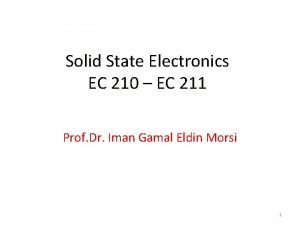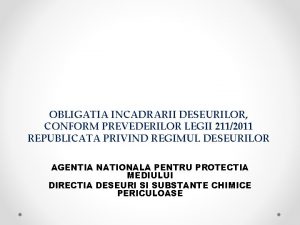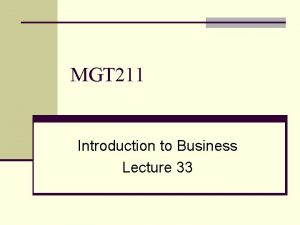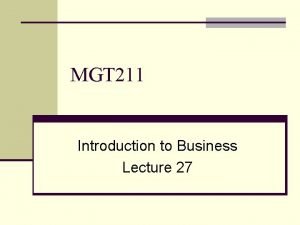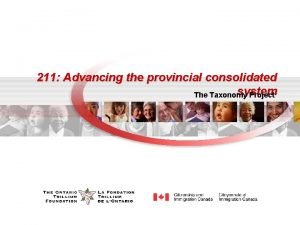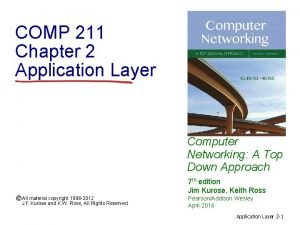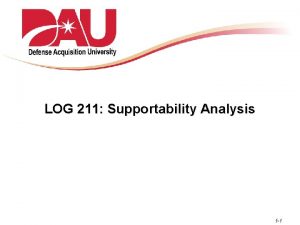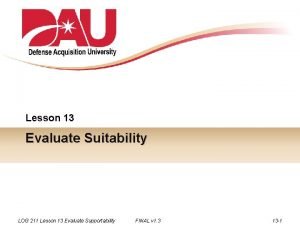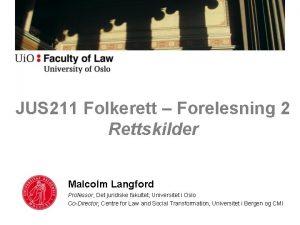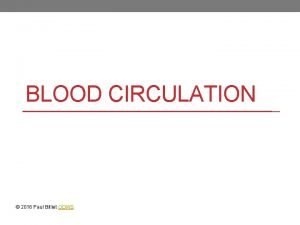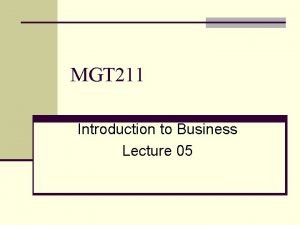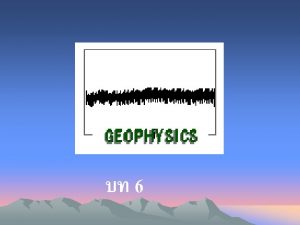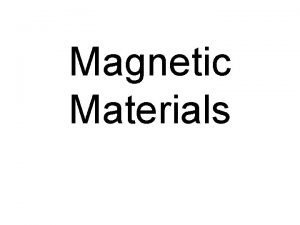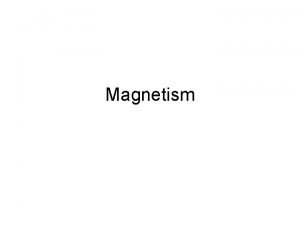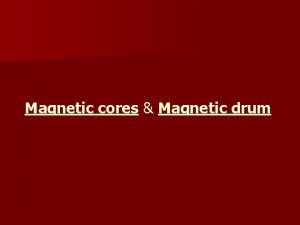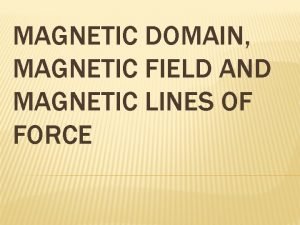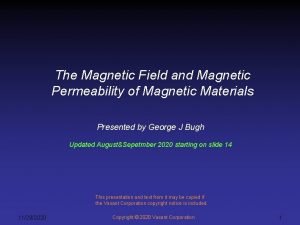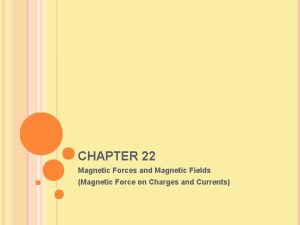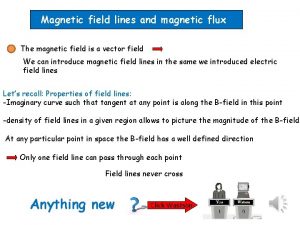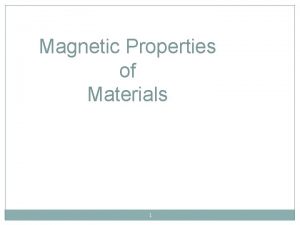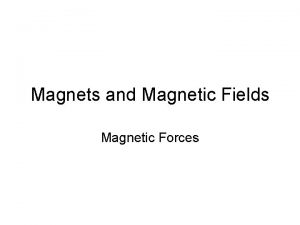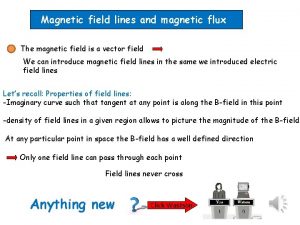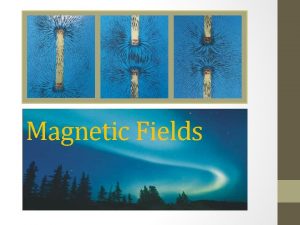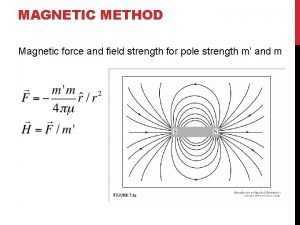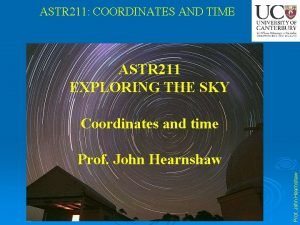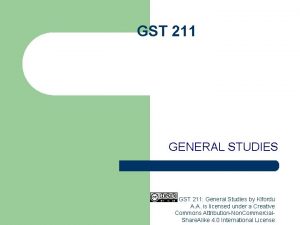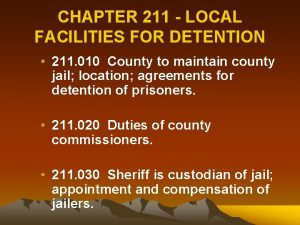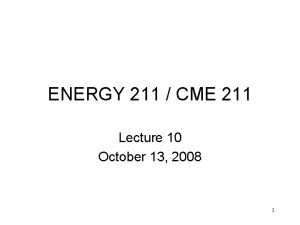Magnetic Method 211 Lectures Structure In these lectures


































- Slides: 34

Magnetic Method 211

Lectures Structure • In these lectures we explore the magnetic methods of geophysical exploration. • The first part covers the fundamental concepts of magnetic force field, the Earth’s magnetic field and its relationship with gravity field. • The second part deals with the measurement procedures and treatment of the magnetic field data, • while third part covers the magnetic effects of simple geometric bodies, processing and interpretation of magnetic data and ending it with treatment, analysis and interpretation of real field data.

Introduction • The Earth is principally made up of three parts: core, mantle and crust (Fig. 1). As understood today, right at the heart of the Earth is a solid inner core composed primarily of iron. At 5, 700°C, this iron is as hot as the Sun’s surface, but the crushing pressure caused by gravity prevents it from becoming liquid. Surrounding this is the outer core, a nearly 2, 000 km thick layer of iron, nickel, and small quantities of other metals. Lower pressure than the inner core means the metal here is fluid. Differences in temperature, pressure and composition within the outer core cause convection currents in the molten metal as cool, dense matter sinks while warm, less dense matter rises.




• This flow of liquid iron generates electric currents, • which in turn produce magnetic fields (Earth’s field). • These convection processes in the liquid part of core (outer core) give rise to a dipolar geomagnetic field that resembles that of a large bar magnet aligned approximately along the Earth’s rotational axis • The mantle plays little part in the Earth’s magnetism, • while interaction of the past and present geomagnetic field with the rocks of the crust produces magnetic anomalies recorded in detailed when surveys are carried out on or above the Earth’s surface. • The magnitude of the Earth’s magnetic field averages to about 5 x 10 -5 T (50, 000 n. T). • Magnetic anomalies as small as 0. 1 n. T can be measured in continental magnetic surveys and may be of geological significance.


Applications of magnetic method • As is well known today, magnetic methods are used to solve various problems such as: • 1. Mapping the basement surface and sediments in oil/gas exploration • 2. Detecting different types of ore bodies in mining prospecting • 3. Detecting metal objects in engineering geophysics • 4. Mapping basement faults and fractures • 5. Determining zones with different mineralization in logging as well as inspecting casing parameters • 6. Studying the magnetic field of the Earth and its generators • 7 -And A variety of other purposes such as natural hazards assessment, mapping impact structures and environmental studies

Fundamental magnetic theories Any magnetic grain is a dipole. That is, it has two poles, P 1 and P 2 of opposite signs diametrically linked. Charles Augustin de Coulomb in 1785 showed that the force of attraction or repulsion between electrically charged bodies and between magnetic poles obeys an inverse square law similar to that derived for gravity by Newton. The mathematical expression for the magnetic force, Fm experienced between two magnetic monopoles is given by: (1) Where μ is a constant of proportionality known as the magnetic permeability, P 1 and P 2 are the ‘strengths’ of the magnetic monopoles and r is the distance between the poles. We note that the expression in equation (1) is identical to the gravitational force,

and electrical force, expressions. Here m 1, m 2 and q 1, q 2 are respectively masses and electrical charges separated by distance r, G is the universal gravitational constant while k is the Coulomb’s law constant for the medium. However, unlike the gravitational constant, G, the magnetic permeability, μ is a property of the material medium in which the two monopoles P 1 and P 2 are situated. If they are placed in a vacuum, then μ is for the free space. Also, unlike m 1 and m 2, P 1 and P 2 can be either positive or negative in sign. If P 1 and P 2 have the same sign, the force, Fm between the two monopoles is repulsive. If P 1 and P 2 have opposite signs, Fm is attractive. We may seem to easily compare the gravitational force between masses m 1 and m 2 separated by r to that of either the attractive or repulsive magnetic force between two monopoles

-However, the magnetic monopoles have never existed! Rather the fundamental magnetic element appears to consist of two magnetic monopoles: one positive and the other negative, separated by a distance. -Thus the fundamental magnetic element consisting of two monopoles is called a magnetic dipole. -Every magnetic grain is therefore a dipole. -We can therefore determine the force produced by a dipole by considering a force produced by two monopoles. Since the dipole is simply two monopoles each of strength P 1 and P 2, we expect that the force generated by a dipole is simply the force generated by one monopole added vectorially to the force generated by the second monopole.

The Earth’s magnetic field https: //www. youtube. com/watch? v=FYri. CZOVb. FQ 1 -Nearly 90% of the Earth’s magnetic field (geomagnetic field) looks like a magnetic field that would be generated from a dipolar magnetic source located at the centre of the Earth and nearly aligned with the Earth’s rotational axis. The strength of the Earth’s field at the poles is about 60, 000 n. T. (This is called the Main Field of the Earth). 2 -The remaining 10% of the Earth’s magnetic field cannot be explained in terms of simple dipolar sources. a)-The larger component of this 10% of the Earth’s field originates in iron-bearing rocks near the Earth’s surface where temperatures are sufficiently low (i. e. less than the Curie temperature of the rocks). This region is confined to the upper 30 – 40 km of the crust and is the source of the crustal field which is made up of induced field on magnetically susceptible rocks and remanent magnetism of the rocks. b)-The smaller portion of the 10% comes from the upper atmosphere (external source).

The external source field is believed to be produced by interactions of the Earth’s ionosphere with the solar wind. Hence some temporal variations (usually variable over hours at tens of n. T or occasionally variable over a few hours at hundreds of n. T: the magnetic storm) are correlated to solar activity. The external component (except for magnetic storm phenomenon) is usually regular and are corrected/removed appropriately from field measurements in a process similar to drift correction in gravity surveys. Where magnetic storm is detected, survey is most often discontinued until the phenomenon has passed.


• The crustal field, its relation to the distribution of magnetic minerals within the crust are the primary subjects of the magnetic method in exploration. In a magnetic survey, the magnetic induction, B whose magnitude is measured at a point is the vector sum of four field components: • 1. The Earth’s main field which originates from dynamo action of conductive fluids in the Earth’s deep interior ; • 2. An induced field caused by magnetic induction in magnetically susceptible earth materials polarized by the main field; • 3. A field caused by remanent magnetism of earth materials; • 4. Other (usually) less significant fields caused by solar, atmospheric and cultural influences

While we can handle the external features (source 4) component (like drift correction in gravity survey: for the solar/atmospheric sources) and divesting from such features or recognizing their transient effects and removing them (for cultural features) the main field is examined from complex models that have been developed and are available. Our intent here is to characterize the global magnetic field (main field) in order to isolate the magnetic field caused by crustal sources (sources 2 and 3).

The magnetic properties of rocks Geologic interpretation of magnetic data requires the knowledge of the magnetic properties of rocks in terms of magnetic susceptibility and remanent magnetization. Magnetic properties of rocks can only exist at temperatures below the Curie point. The Curie temperature is found to vary within rocks but is often in the range 550 C to 600 C.

Indeed rock magnetism is a subject of considerable complexity. Clearly, all crustal rocks find themselves situated within the geomagnetic field. These crustal rocks are therefore likely to display induced magnetization given by equation , where the magnitude of magnetization(Ji), is proportional to the strength of the Earth’s field (T) , The magnetic susceptibility(k), is actually the magnetic volume susceptibility that is encountered in exploration. Apart from the induced magnetization, many rocks also show a natural remanent magnetization (NRM) that would remain even if the present-day geomagnetic field ceases to exist. The simplest way in which NRM can be acquired is through the process of cooling of rocks in molten state. As the rocks cool past the Curie point (or blocking temperature) a remanent magnetization in the direction of the prevailing geomagnetic field will be acquired. The magnitude and direction of the remanent magnetization can remain unchanged regardless of any subsequent changes in the ambient field.

Classifications of Magnetic Susceptibility (how do materials behave in a magnetic field? )

Diamagnetic: Electrons are paired, but orbits induce a small net magnetic moment Very small negative (k) Moment is near zero. Examples: quartz & feldspar Paramagnetic: Unpaired electrons partially align Positive typically very low Moment is typically small. Examples: pyroxene & olivine


Magnetic Domains 1 -Ferromagnetic and Ferrimagnetic materials generally made up of domains with uniform magnetic direction within domains the magnetic moments of atoms are aligned. 2 - The domains form when cooled below the Curie Temperature. Magnetism can be either permanent or induced Permanent magnetism remains when the field is removed. For surveys, magnetism induced by the Earth’s field is generally the most important during the surveys

Classifications of Magnetic Susceptibility Ferromagnetic: Domains within the material are aligned. Very high (k) Common examples are pure iron, nickel Do not occur naturally on Earth. Anti-Ferromagnetic: Domains within the material are both anti -parallel and parallel , with both orientations having the same strength. is very low Moment = 0 Common example is hematite. Ferrimagnetic: Domains within the material are both anti parallel and parallel, with one direction being stronger than the other. High Common examples are magnetite* and ilmenite.


Magnetic Susceptibility of Naturally Occurring Materials http: //www. epa. gov/

Magnetic Field Nomenclature • As you can see, although we started by comparing the magnetic field to the gravitational field, the specifics of magnetism are far more complex than gravitation. Despite this, it is still useful to start from the intuition you have gained through your study of gravitation when trying to understand magnetism. • Before continuing, however, we need to define some of the relevant terms we will use to describe the Earth's magnetic field. • When discussing gravity, we really didn't talk much about how we describe gravitational acceleration. To some extent, this is because such a description is almost obvious; gravitational acceleration has some size (measured in geophysics with a gravimeter in m. Gals), and it is always acting downward (in fact, it is how we define down). • Because the magnetic field does not act along any such easily definable direction, earth scientists have developed a nomenclature to describe the magnetic field at any point on the Earth's surface. • https: //www. youtube. com/watch? v=FYKWSErq. FD 8


the magnetic field, F*, has some strength and points in some direction. The following terms are used to describe the direction of the magnetic field. • Declination : Magnetic declination, or magnetic variation, is the angle on the horizontal plane between magnetic field lines (the direction the end of a magnetized compass needle points, corresponding to the direction of the Earth's magnetic field lines) and true north (the direction along a meridian towards the geographic North Pole). This angle varies depending on position on the Earth's surface and changes over time.


• Inclination Is the angle made with the horizontal by the Earth's magnetic field lines. This angle varies at different points on the Earth's surface. Positive values of inclination indicate that the magnetic field of the Earth is pointing downward, into the Earth, at the point of measurement, and negative values indicate that it is pointing upward.

• Magnetic Equator - The location around the surface of the Earth where the Earth's magnetic field has an inclination of zero (the magnetic field vector F is horizontal). This location does not correspond to the Earth's rotational equator.

Magnetic Poles - The locations on the surface of the Earth where the Earth's magnetic field has an inclination of either plus or minus 90 degrees (the magnetic field vector F is vertical). These locations do not correspond to the Earth's north and south poles.

Why does a magnetic compass point to the Geographic North Pole? • A magnetic compass does not point to the geographic north pole. A magnetic compass points to the earth's magnetic poles, which are not the same as earth's geographic poles. Furthermore, the magnetic pole near earth's geographic north pole is actually the south magnetic pole. When it comes to magnets, opposites attract. This fact means that the north end of a magnet in a compass is attracted to the south magnetic pole, which lies close to the geographic north pole. Magnetic field lines outside of a permanent magnet always run from the north magnetic pole to the south magnetic pole. Therefore, the magnetic field lines of the earth run from the southern geographic hemisphere towards the northern geographic hemisphere • https: //www. wtamu. edu/~cbaird/sq/2013/11/15/why-does-a-magneticcompass-point-to-the-geographic-north-pole/
 Hysteresis loop magnetism
Hysteresis loop magnetism Magnetic induction unit in weber
Magnetic induction unit in weber Magnetic moment and magnetic field relation
Magnetic moment and magnetic field relation F=i(lxb)
F=i(lxb) Symposium technique
Symposium technique Opwekking 211
Opwekking 211 211 miller indices
211 miller indices 211 snohomish county
211 snohomish county Poli 211
Poli 211 Physics 211 exam 1
Physics 211 exam 1 Legea 211/2011
Legea 211/2011 Mgt 211
Mgt 211 A product can be mgt211
A product can be mgt211 Is 211 nationwide
Is 211 nationwide Csce 211
Csce 211 211 la taxonomy
211 la taxonomy Buck destello
Buck destello Csce 211
Csce 211 Comp 211
Comp 211 Comp 211
Comp 211 Comp 211
Comp 211 211 org md
211 org md 매트랩 subplot
매트랩 subplot Nur 211 final exam
Nur 211 final exam Supportability analysis training
Supportability analysis training Asoe model
Asoe model Jus 211
Jus 211 211 orange county
211 orange county Csce 211
Csce 211 The prologue to the canterbury tales characters
The prologue to the canterbury tales characters Bio 211
Bio 211 Importance of joint stock company
Importance of joint stock company Gd 211
Gd 211 Gc 211
Gc 211 Fda gmp training
Fda gmp training






